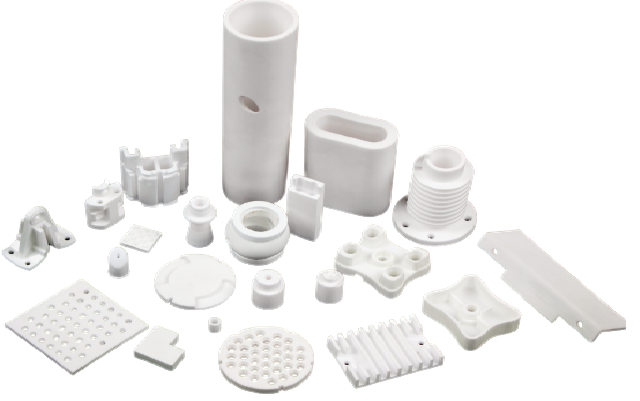Everything You Need To Know About Alumina Ceramics

Alumina ceramics are highly advanced ceramic materials basically composed of
oxygen and aluminum. A lot of manufacturers choose aluminum oxide ceramics due
to their high thermal conductivity, insulating ability as well as their
resistance to corrosion and their extreme hardness. They are utilized in a
variety of manufacturing processes.
We'll be discussing the properties, production, and application of alumina oxide,
along with any other relevant information regarding the alumina ceramic
material. Let's dive in already!
What is Alumina Ceramics?
Alumina ceramic, commonly referred to as alumina or aluminum oxide (Al2O3) is
an industrial-grade oxide ceramic that is renowned for its extreme hardness and
high thermal conductivity. The advantages of alumina-based ceramics makes them
one of the most widely employed ceramics in construction, wear and corrosive
environments.
Alumina ceramics are usually made by bauxite. They are formed by injection
molds, die pressing, isostatic pressing, slip casting, diamond machining, as
well as extrusion. Similar to aluminum nitride and important engineering
materials, alumina can be produced by dry press and sinter or by hot pressing
using appropriate sintering tools.
Alumina-based ceramics are among the most studied and characterized advanced
ceramic materials known today. Due to the important combination of their
properties that they possess, their behavior has been extensively studied.
Alumina is known for its high hardness, excellent resistance to corrosion
excellent thermal stability, excellent dielectric properties (for changing from
DC to frequencies of GHz) and tangents with low loss, and stiffness. For more
information about the properties and applications of ceramics made from alumina,
look up the following section.
The properties of Alumina Ceramics
Based on the amount of Al2O3 and the additives that are used in the
production of aluminum oxide mateials.
Based on the Al2O3 content, alumina may be classified as 75% alumina 85 %
alumina, 95% alumina, 99.99 alumina, and so on.
Based on the differences in the crystal phase, there are mullite,
corundum-mullite, and corundum;
The various additives that are used are classified into chromium Corundum,
titanium Corundum and many others.
Alumina is a fantastic electrical insulator, which is resists to
high-currents, and its resistance to electricity increases depending on its
purity. The more pure alumina is more pure, the greater the resistance would
be.
It is well-known that Alumina is a material with a high melting point and a
strong mechanical strength. The strength of its mechanical properties decreases
when temperatures rise above 1000 ° Celsius. Due to the huge variation in its
coefficient of thermal expansion, it is less susceptible to shocks caused by
thermal when exposed to extreme temperatures.
The excellent chemical stability of Alumina is a major reason for its
resistance to corrosion.
Alumina can also be dissolved in certain powerful acids (such as hot
sulfuric, hot HCl or HF). and alkaline solutions, however it is not soluble in
water. Pure alumina is able to resist corrosion caused by chemical, making the
purest alumina the preferred material for engineering components in a variety of
industrial applications. Its low solubility in chemical is what makes it
resistant to chemical corrosion.
Additives are used to improve the physical and chemical properties of
alumina. Combining these additives with other production methods can enable the
production of alumina ceramics of a variety dimensions and shapes.
Ceramics made of Alumina have the lowest vapor and decomposition
pressures.
Alumina ceramics, as we all know, are like aluminum Nitride due to their
excellent thermal conductivity.
Application of Alumina Ceramics
Due to their superior chemical stability, alumina-based ceramics are used
widely in acid-resistant pump impellers pipes carrying acid, pump body linings
and valves.
Ceramics made of aluminum oxide are used in the production of textile wear
parts and knives. They are extremely hardy and durable to wear.
Alumina ceramic materials are used in making spark plugs, which are
beneficial in a wide variety of engines.
Transparent alumina ceramics are utilized in making high-pressure sodium
lamps and infrared detection windows.
Alumina ceramics contain more than 95% alumina content and are excellent
electrical insulation. Ceramics made of alumina also have a low loss dielectric,
making them ideal for use in electronic and electrical appliances.
Transparent aluminum oxide exhibits excellent permeability to visible light
and infrared light.
Additional uses of zirconia ceramic, include seal rings as well as medical
prostheses and laser tubes. Thermocouple tubes electronic substrates, electronic
substrates.
Conclusion
Alumina ceramics are composed of aluminum oxide. Alumina ceramics are extremely flexible because of their high thermal conductivity and resistance to heat.
Comments
Post a Comment